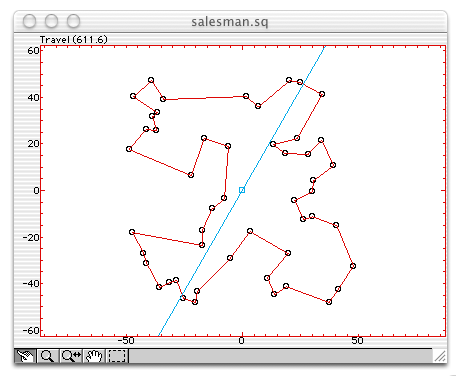Sysquake Pro – Table of Contents
Sysquake for LaTeX – Table of Contents
salesman.sq
Minimization of the travel of a salesman
The problem of the salesman consists in minimizing the closed travel which links a set of towns. All towns must be visited exactly once. No known algorithm exists, except for an exhaustive search. The proposed SQ file is not intended to provide an efficient optimization method, but to show how Sysquake can be used with an idle handler to run continuously. The ability to move the towns interactively and to observe how the travel is optimized in subtle ways is fascinating.

First contact
A salesman must visit all the towns and come back to his starting point. He
wants to minimize the length of the total journey. The figure represents
each town with a circle, and the journey with a red line
To add some fun to the optimization, the salesman must avoid crossing the river too many times. Crossing the river adds a penalty which can be chosen in the Settings menu (a negative penalty means that the salesman likes crossing the river). The river and each town can be moved interactively with the mouse. The river may also be put in Automatic Rotation mode in the Settings menu.
Figures
Travel
The towns are displayed as black circles; the travel is displayed as a closed red line which links all the towns; and the river is displayed as a vertical line, blue if it is associated with a positive penalty (which minimizes the number of crossings) and green if it is associated with a negative penalty. The towns and the river can be moved interactively.
Statistics
The total length of the travel is displayed against the number of iterations of the optimization. A threshold is displayed as a horizontal line and can be adjusted interactively. When it is above the current local minimum, permutations which can increase the length of the travel up to this level are allowed and chosen randomly. When the level is decreased, the length may reach a lower local minimum.
Settings
Improve
Performs one step of optimization, i.e. one permutation which will either decrease the total length of the travel or pick randomly a permutation below the threshold fixed in the Statistics figure.
Automatic Run
When checked, the optimization runs automatically.
Automatic River Rotation
When checked, the river rotates slowly.
Number of Towns
A dialog is displayed, where the number of towns can be changed. If the OK button is clicked (whether the number of towns has been changed or not), the town positions are chosen randomly.
River Penalty
A dialog is displayed, where the penalty associated with each crossing of the river can be changed. The penalty is expressed as a distance, positive to reduce the number of crossings and negative to increase it. When you choose a large value (e.g. 100), the river is crossed only twice if there are towns on each side. This is clearly visible when you move the river if Automatic Run is checked.